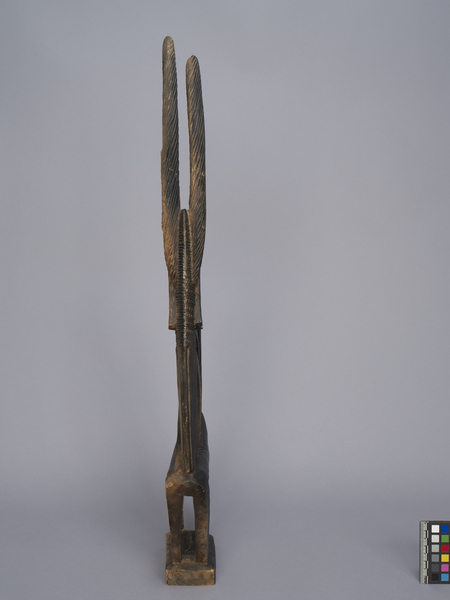Headdress Item Number: 3123/28 from the MOA: University of British Columbia



Description
Wooden antelope headdress. Cut from a single piece of wood, the animal has a long, thin head with curved horns arching high above, a prominent neck constructed of several curved lines of wood cut into strips and blocks decorated with triangular gouges, and a rectangular lower half with square legs and a small rectangular base. Object has been stained a mottled dark brown.
History Of Use
A male Chi Wara (Ci Wara, Tyi Wara) headdress that is made to be danced as a pair with a female mask at harvest festivals to honour Chi Wara, a half human and half antelope mythical being who taught agriculture to the ancestors of the Bamana people. When humans became wasteful, Chi Wara buried himself in the earth and the Bamana created headdresses to represent him. Together, the male and female headdresses embody the ingredients necessary for successful cultivation. The dancers would hold sticks in their hands, to represent the movements Chi Wara made when he taught men how to cultivate, and the women would sing songs of praise for Chi Wara and the farmers. The headdress is attached to a wicker cap, which is strapped around the chin of a dancer.
Specific Techniques
The wood is oiled and then charred in fire to deepen the colour.
Iconographic Meaning
The headdresses are inspired by antelopes, armoured pangolins, and aardvarks. The antelope head represents the strength and grace needed to farm. The armoured pangolin's body represents protection, and the aardvark's legs represent good digging needed for farming. The male Chi Wara headdress represents the sun, while the female one represents the earth. The long horns represent the tall growth of millet. The fibre ties of the wicker cap, that the headdress would have been attached to, are associated with streams of water.
Item History
- Made in Mali
- Owned by Cornelia Hahn Oberlander before July 22, 2015
- Received from Cornelia Hahn Oberlander (Donor) on July 22, 2015
What
Who
- Culture
- Bamana
- Previous Owner
- Cornelia Hahn Oberlander
- Received from
- Cornelia Hahn Oberlander (Donor)
Where
- Holding Institution
- MOA: University of British Columbia
- Made in
- Mali
When
- Ownership Date
- before July 22, 2015
- Acquisition Date
- on July 22, 2015
Other
- Condition
- fair
- Accession Number
- 3123/0028